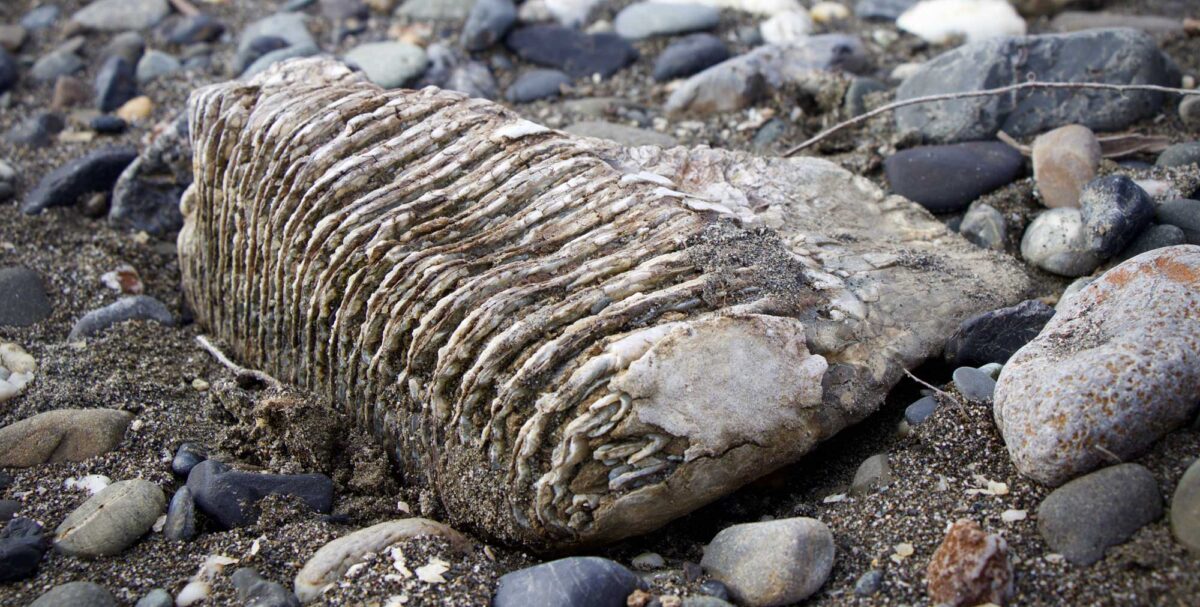
Page snapshot: Introduction to the fossils of Alaska.
Topics covered on this page: Precambrian and Paleozoic fossils; Mesozoic fossils; Mesozoic marine fossils; Triassic marine fossils; Jurassic marine fossils; Cretaceous marine fossils; Cretaceous terrestrial fossils; Cretaceous fossils of Denali National Park; Cretaceous Colville River dinosaurs; Cenozoic fossils; Paleogene fossils; Neogene fossils; Quaternary fossils; Pleistocene mummies; The woolly mammoth; Resources.
Credits: Most of the text on this page comes from "Fossils of the Western US" by Brendan M. Anderson, Alexandra Moore, Gary Lewis, and Warren D. Allmon, chapter 3 in The Teacher-Friendly Guide to the Geology of the Western US, edited by Mark D. Lucas, Robert M. Ross, and Andrielle N. Swaby (published in 2014 by the Paleontological Research Institution; currently out of print). The book was adapted for the web by Elizabeth J. Hermsen and Jonathan R. Hendricks in 2022. Changes include formatting and revisions to the text and images. Credits for individual images are given in figure captions.
Updates: Page last updated May 26, 2022.
Image above: A mammoth tooth on the bank of the Noatak River, Noatak National Preserve, Alaska. Photo by Julia Schock, National Park Service/NPS (public domain).
Precambrian and Paleozoic fossils
Precambrian fossils
Although most of Alaska had not been assembled before the Mesozoic, the state does contain fossil-bearing rocks dating as far back as the Precambrian. The weakly metamorphosed Precambrian rocks in eastern Alaska contain stromatolites, layered, mound-shaped fossils built by cyanobacteria.
Paleozoic fossils
Carboniferous rocks found in parts of northern Alaska, including the Brooks Range, Point Hope, and Gates of the Arctic National Park, contain corals, brachiopods, gastropods, and crinoids.
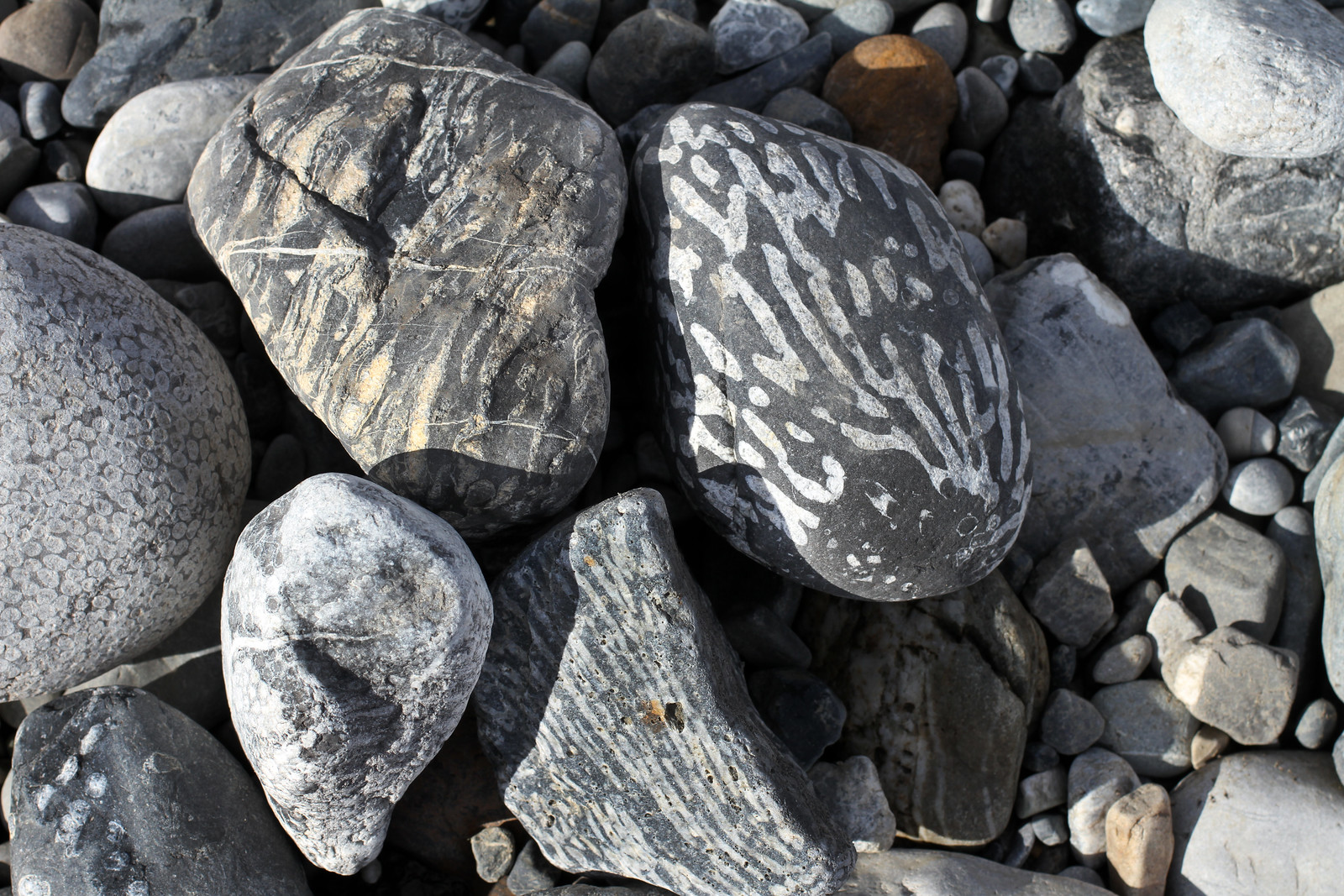
Pieces of gravel with preserved corals, Canning River, Alaska. Photo by Katrina Liebich/USFWS (Alaska Region U.S. Fish & Wildlife Service on flickr, Creative Commons Attribution-NonCommercial-NoDerivs 2.0 Generic license).
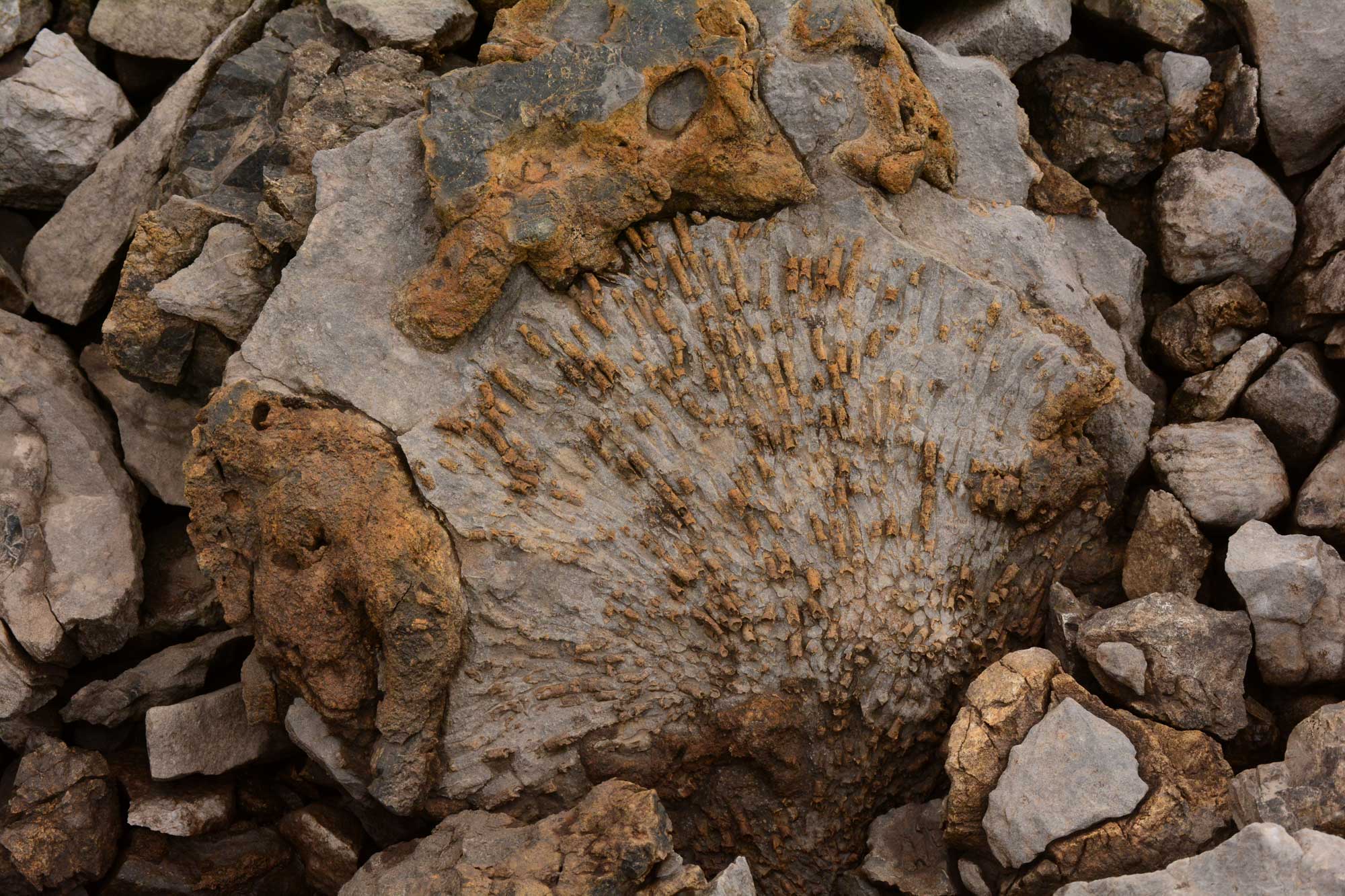
Fossil coral, Brooks Range, Alaska. Photo by Paxson Woelber (Wikimedia Commons, Creative Commons Attribution-ShareAlike 3.0 Unported license, image resized).
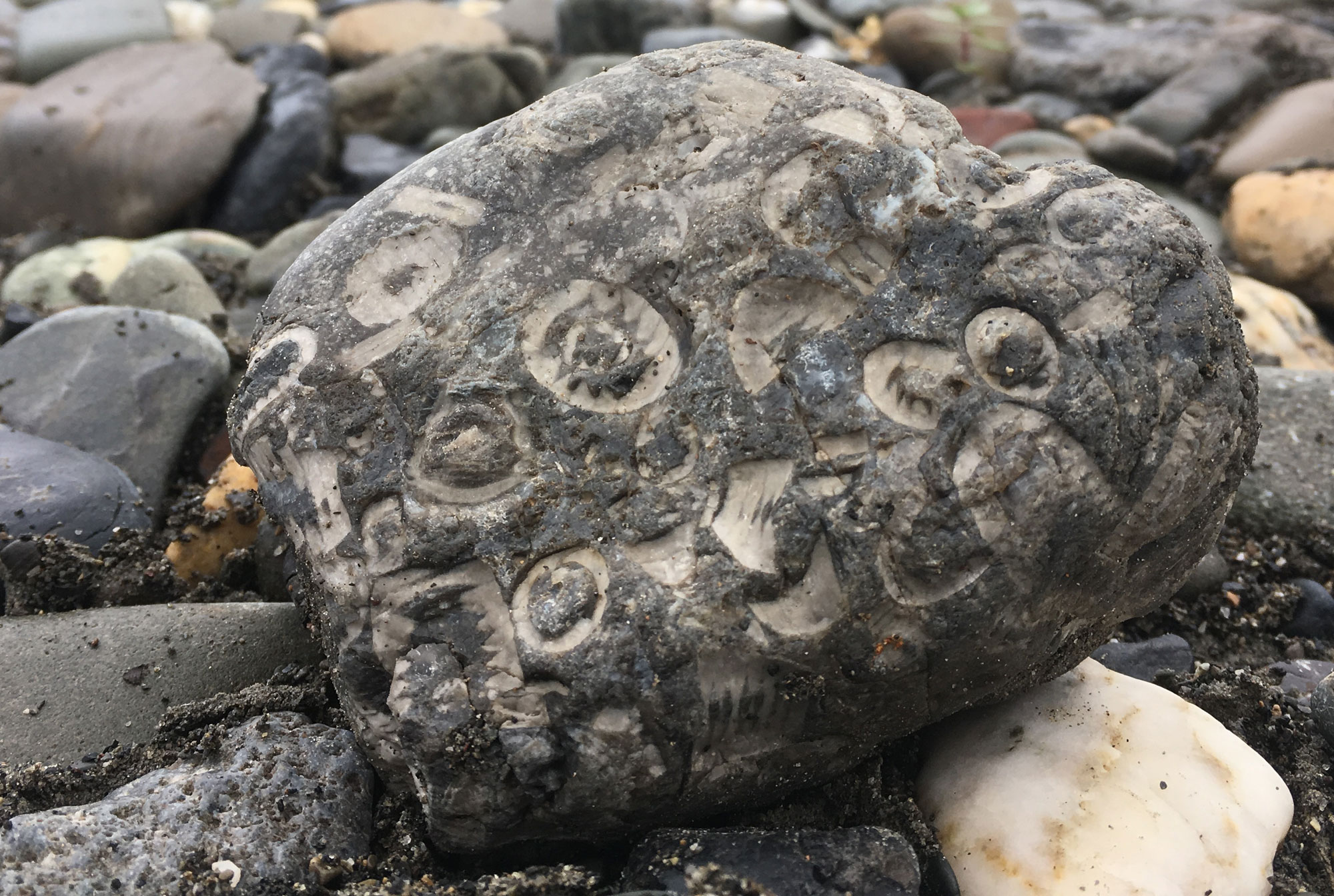
A piece of gravel with worn-down crinoid stem segments on the bank of the Noatak River, Noatak National Preserve, Alaska. Photo by Julia Schock, National Park Service/NPS (public domain).
Mesozoic fossils
Mesozoic marine fossils
Triassic marine reptiles
Triassic marine reptiles are rare in Alaska. An unnamed ichthyosaur from the Brooks Range in northern Alaska is similar to Shonisaurus, a genus of large Triassic ichthyosaurs from Nevada (read more about Shonisaurus at in Earth Science of the Western United States: Fossils of the Basin and Range). A fairly complete specimen of a thalattosaurid, another type of marine reptile, was found in the Keku Islands of southeastern Alaska.

A thalattosaurid (Gunakadeit joseeae) from the Triassic Hound Island Volanics, Keku Islands, southeastern Alaska. The genus is named after the Gunakadeit, a sea monster in Tlingit mythology. Paleontologists consulted with the Tlingit community before using the name for the fossil. Photo source: Figure 2 from Druckenmiller et al. (2020) Scientific Reports (Creative Commons Attribution license)
Jurassic marine fossils
Jurassic marine rocks in Alaska, which are found around Iliamna Lake in southern Alaska and across the Brooks Range on the North Slope, contain abundant ammonites and bivalves.
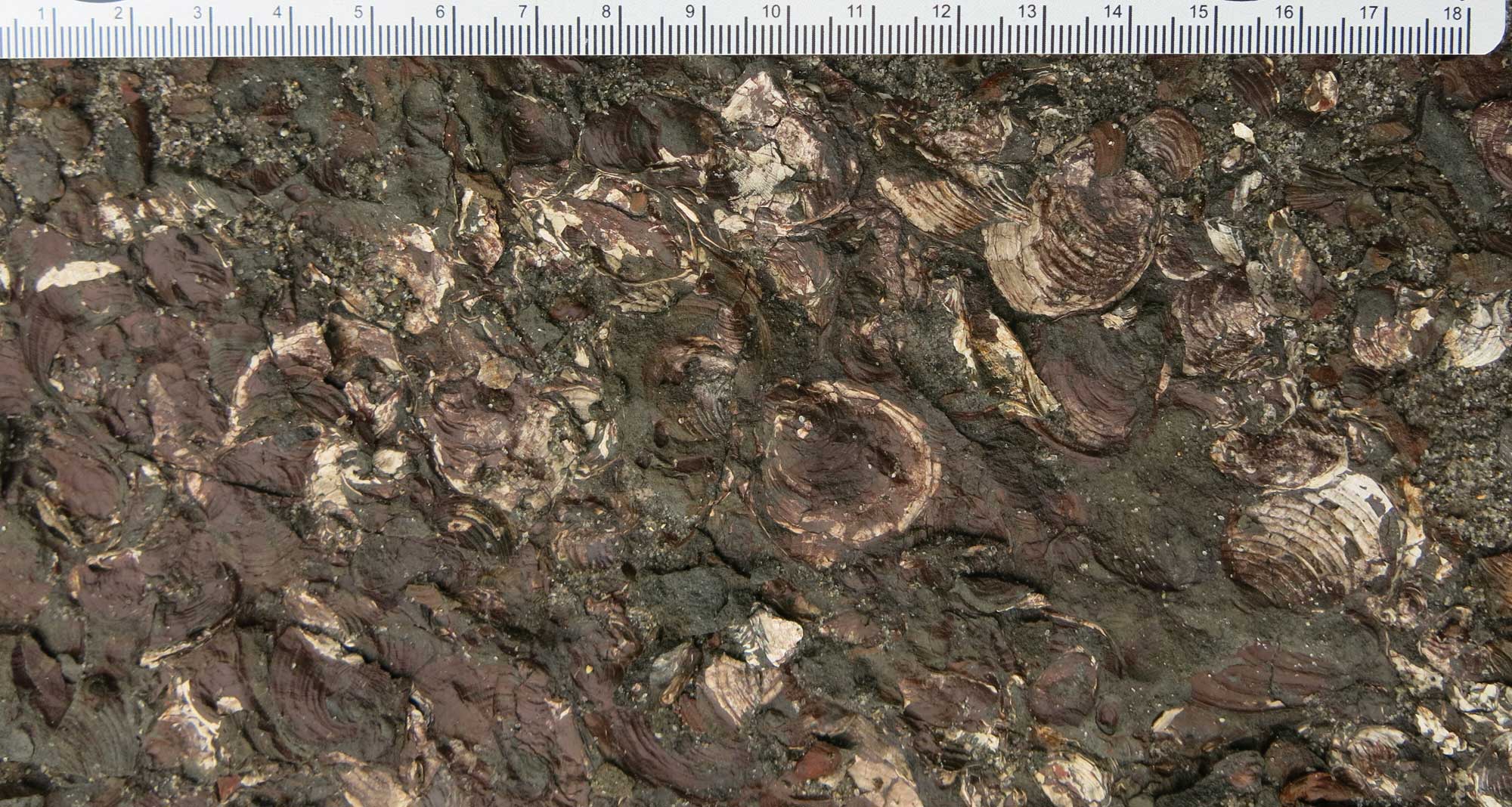
Bivalves (Buchia mosquensis), Jurassic Naknek Formation, Ukak River, Alaska. Photo by Chad Hults (National Park Service/NPS, public domain).
3D model of a bivalve (Pleuromya), Jurassic Tuxedni Group, Lake Clark National Park and Preserve, Alaska. Width = 4 centimeters (1.6 inches). Source: Alaska National Parks Geology on Sketchfab (Creative Common Attribution 4.0 International license).
3D model of a ammonite (Emileia constricta), Jurassic Tuxedni Group, Lake Clark National Park and Preserve, Alaska. Width = 5 centimeters (about 2 inches). Source: Alaska National Parks Geology on Sketchfab (Creative Common Attribution 4.0 International license).
Cretaceous marine fossils
Shallow marine rocks from the Cretaceous are well represented on Alaska’s Northern Coastal Plain, around Norton Sound, the Kuskokwim Mountains, the Kenai Peninsula, and Kodiak Island. The Brooks Range and other mountains arose during the Cretaceous, which led to extensive erosion and deposition of sediment in shallow marine environments and coastal swamps. Alaska’s Cretaceous marine fossils are dominated by modern groups such as gastropods and bivalves, although ammonoids are also found.

An ammonoid (Pacydiscus kamishakensis), Cretaceous Kaguyak Formation, Alaska. Photo National Park Service/NPS (public domain).
3D model of an ammonite (Pachydiscus hazzardi), Late Cretaceous Kaguyak Formation, Katmai National Park, Alaska. Diameter = about 50 centimeters (almost 20 inches). Source: Alaska National Parks Geology on Sketchfab (Creative Common Attribution 4.0 International license).
Cretaceous terrestrial fossils
Cretaceous fossils of Denali National Park
Alaska reached its present latitude during the Cretaceous, when the world as a whole was much warmer. Fossils of dinosaurs, dawn redwoods, ginkgoes, and other species are common in Alaskan rocks. Fossil dinosaur tracks that are about 70 million years old have been discovered in the Cantwell Formation in Denali National Park.
Plant fossils from the Late Cretaceous, Denali National Park, Alaska. Leaves labeled on the specimen include a cycad, a dawn redwood (Metasequoia), a laurel-like plant, and an ancient sycamore. Source: Denali National Park and Preserve on Sketchfab (Creative Common Attribution-NonCommercial-NoDerivs license).

Fossil trackway at Denali National Park, Alaska. Photo by Nadine Reitman, GIP (National Park Service/NPS, public domain).
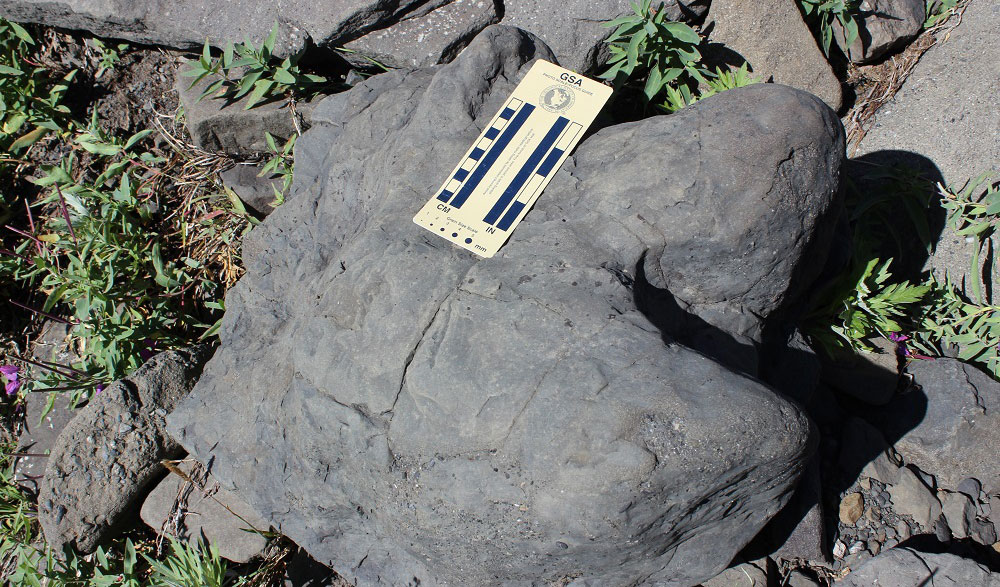
Hadrosaur track at Denali National Park, Alaska. Photo by Montana Hodges, GIP (National Park Service/NPS, public domain).
Bird tracks, Late Cretaceous Cantwell Formation, Denali National Park, Alaska. Source: Denali National Park and Preserve on Sketchfab (Creative Common Attribution-NonCommercial-NoDerivs license).
Cretaceous Colville River dinosaurs
Some Late Cretaceous dinosaurs found near the Colville River on the North Slope (northern Alaska) are spectacularly well preserved, containing more than half of their original bone material. Alaskan dinosaurs included herbivorous ceratopsians (horned dinosaurs) such as Pachyrhinosaurus; Alaskacephale, a pachycephalosaur (dome-headed dinosaurs with thick skulls); hadrosaurs (duck-billed dinosaurs) like Ugrunaaluk; ankylosaurs (armored dinosaurs), such as Edmontonia, the first dinosaur discovered in Alaska. Alaska even has its own tyrannosaur, Nanuqsaurus, which was about half the length of Tyrannosaurus rex. Other carnivores included Albertosaurus and possibly Gorgosaurus. These dinosaurs lived in conifer forests where ginkgoes and angiosperms (flowering plants) also grew.
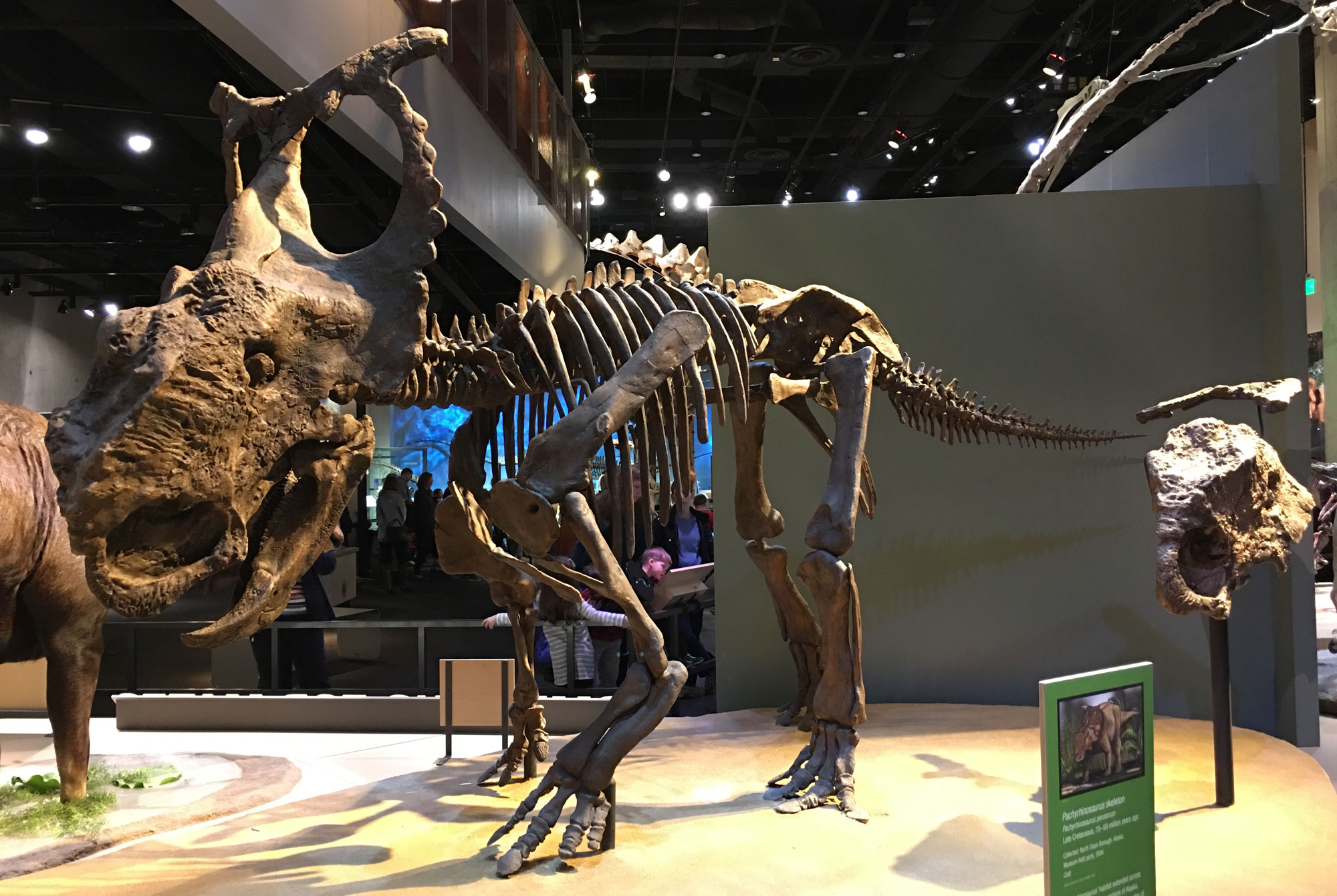
Skeleton of the ceratopsian (horned dinosaur) Pachyrhinosaurus perotorum from the Cretaceous of the North Slope of Alaska. Specimen on display in the Perot Museum, Dallas, Texas. Source: Photo by bryan... (Wikimedia Commons, Creative Commons Attribution-ShareAlike 2.0 Generic license, image cropped and resized).
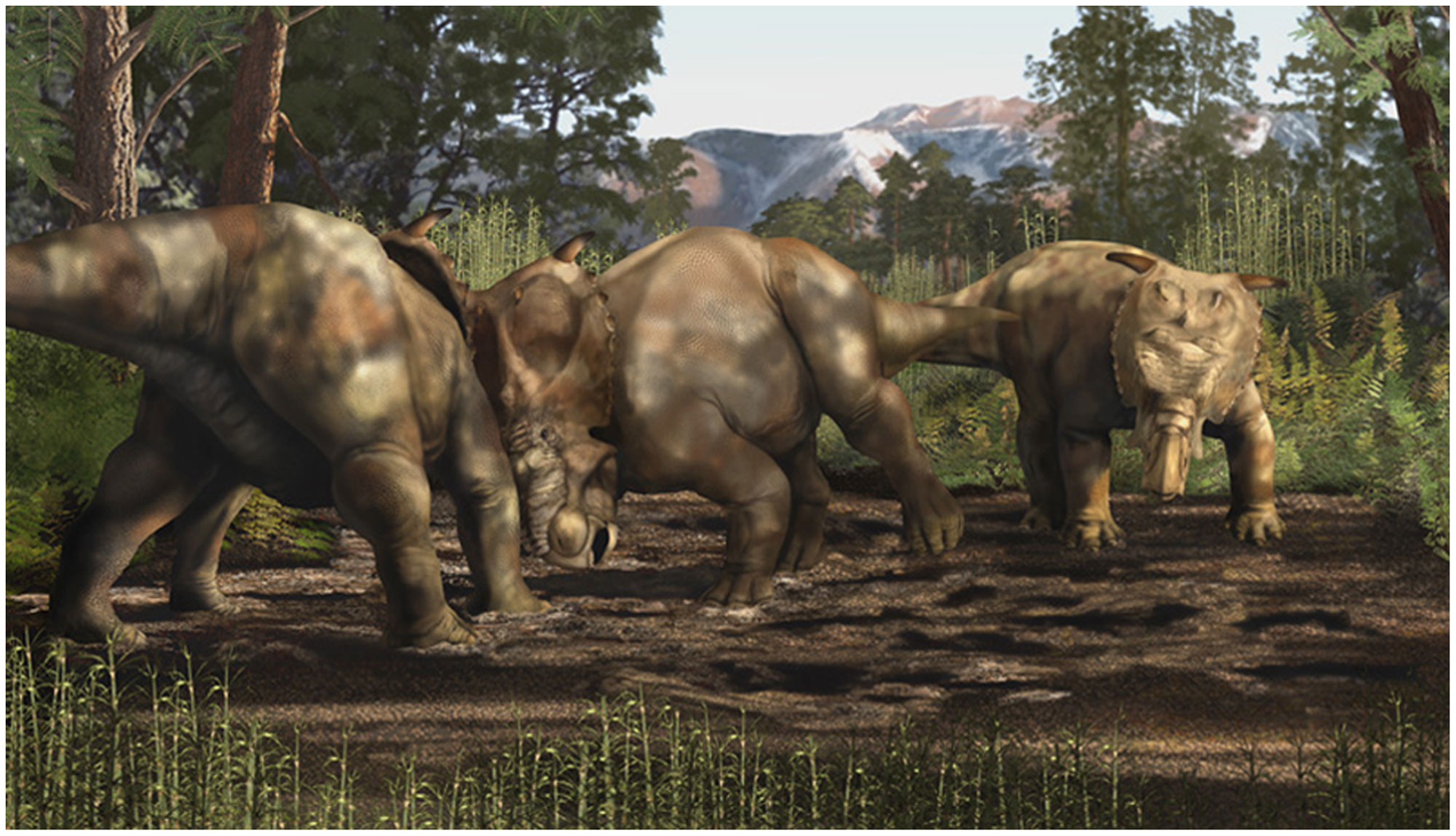
Reconstruction of Pachyrhinosaurus perotorum by K. Carr. Source: Fiorillo & Tykoski (2013) PLoS ONE 8(6): e65802 (Creative Commons Attribution License).
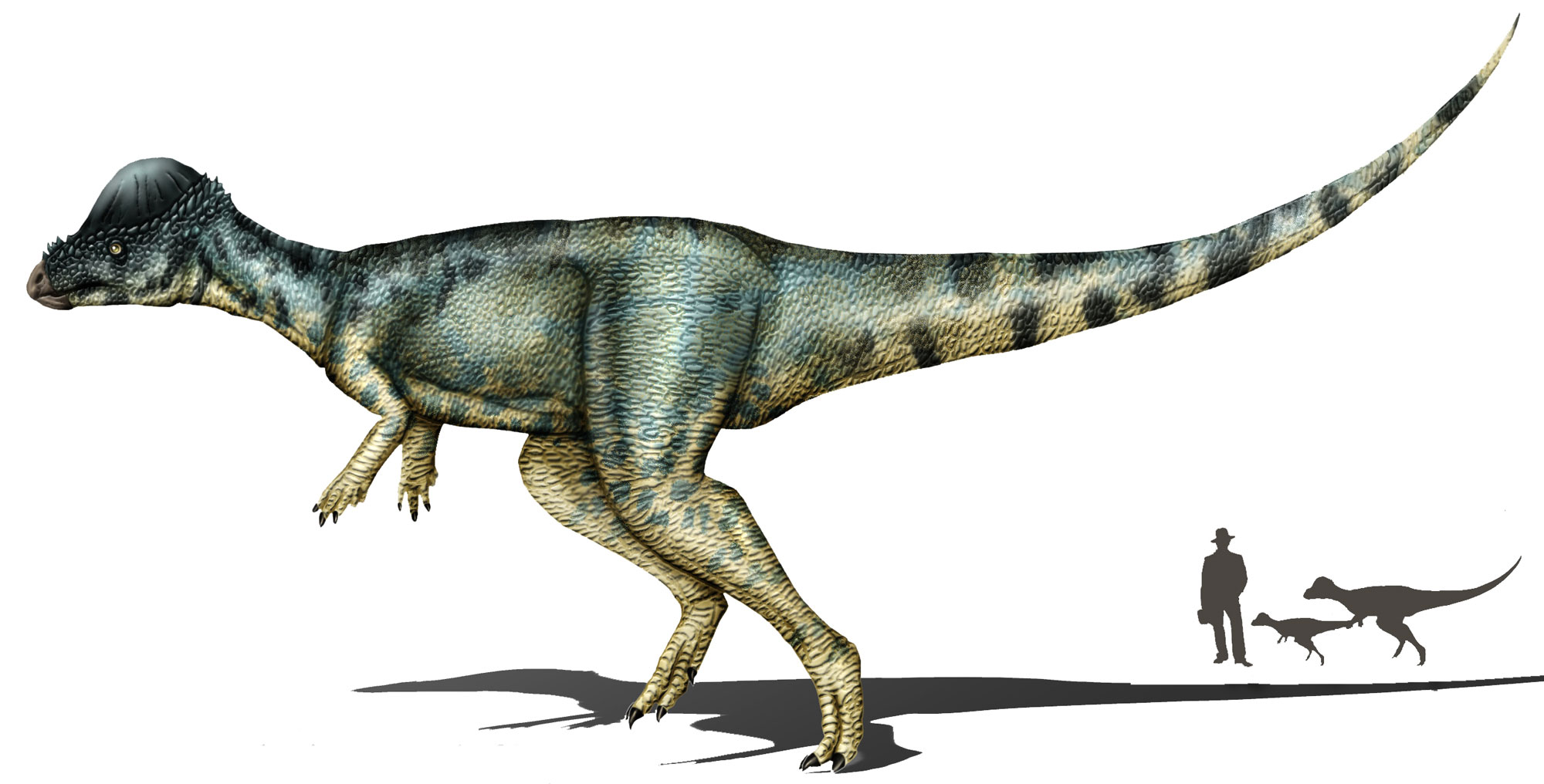
Reconstruction of the pachycephalosaur Alaskacephale gangloffi by Karkemish (Wikimedia Commons, Creative Commons Attribution 3.0 Unported, image resized).
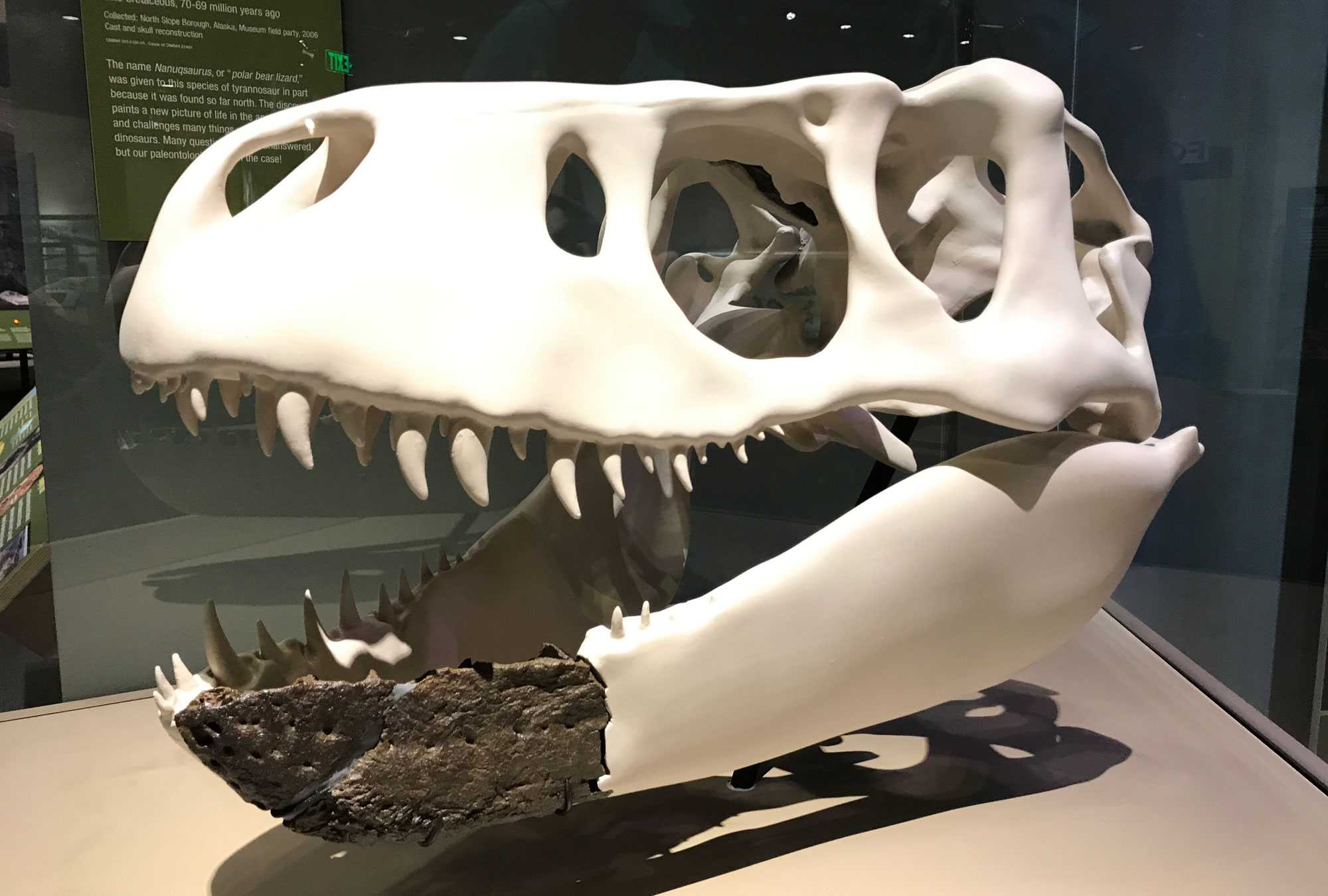
Reconstructed skull of the tyrannosaur Nanuqsaurus; bones are brown, interpreted parts of the skull are white. Specimen on display in the Perot Museum, Dallas, Texas. Photo by Jonathan Cutrer (flickr, Creative Commons Attribution 2.0 Generic license, image cropped and resized).
Cenozoic fossils
Paleogene fossils
Paleogene fossils indicate that Alaska's climate was much warmer than it is today. In addition to plants that may occur in Alaska today, like alder (Alnus), plants characteristic of warmer climates have been found. Most notable among these are palm leaves, which have been found in southeastern Alaska in sites near the Gulf of Alaska and on Kupreanof Island. The occurrence of palms in southern Alaska is consistent with the high global temperatures that occurred in the Paleocene and Eocene.

Fossil fern, Wrangell-St. Elias National Park and Preserve, Alaska. The name and age of this specimen were not identified, but it is similar to the Eocene species Dryopteris alaskana that has been reported from the region. Photo by National Park Service (public domain).
3D model of an unidentified chunk of petrified wood, Paleocene to Eocene Ketavik Formation, Katmai National Park, Alaska. Width = 14 centimeters (5.5 inches). Source: Alaska National Parks Geology on Sketchfab (Creative Common Attribution 4.0 International license).
Neogene fossils
In Alaska’s Neogene rocks, which occur mostly along the southern coast and onto the peninsula, gastropods and bivalves are the most common marine fossils.
Land plants preserved in these rocks include many familiar tree species, like willows, poplars, alders, birches, oaks, beeches, and elms. The flora also includes some types of trees native only in Eurasia today, like dawn redwood (Metasequoia), ginkgo (Ginkgo), katsura (Cercidiphyllum), and zelkova (Zelkova).

Mollusk fossils from the Miocene Narrow Cape Formation, Fossil Beach, Kodiak Island, Alaska. Photo by Arthur T. LaBar (flickr, Creative Commons Attribution-NonCommercial 2.0 Generic license, image cropped and resized).
Desmostylians
Desmostylians are a group of enigmatic Oligocene to Miocene mammals that looked like and probably lived in similar habitats to modern hippos. Desmostylians are found only around the northern edges of the Pacific Ocean. In the eastern Pacific, they are found on the West Coast of North America from the Aleutian Islands in Alaska to Mexico. The modern relatives of these animals are unknown.
Desmostylian fossils are rare in Alaska. Only two species are known, both collected from Unalaska Island in the Aleutian Islands. The older is the Oligcene species Cornwallius sookensis, which ranged all the way south to Baja California Sur, Mexico. The younger is the Miocene species Ounalashastylus tomidai, which has been found only on Unalaska Island.
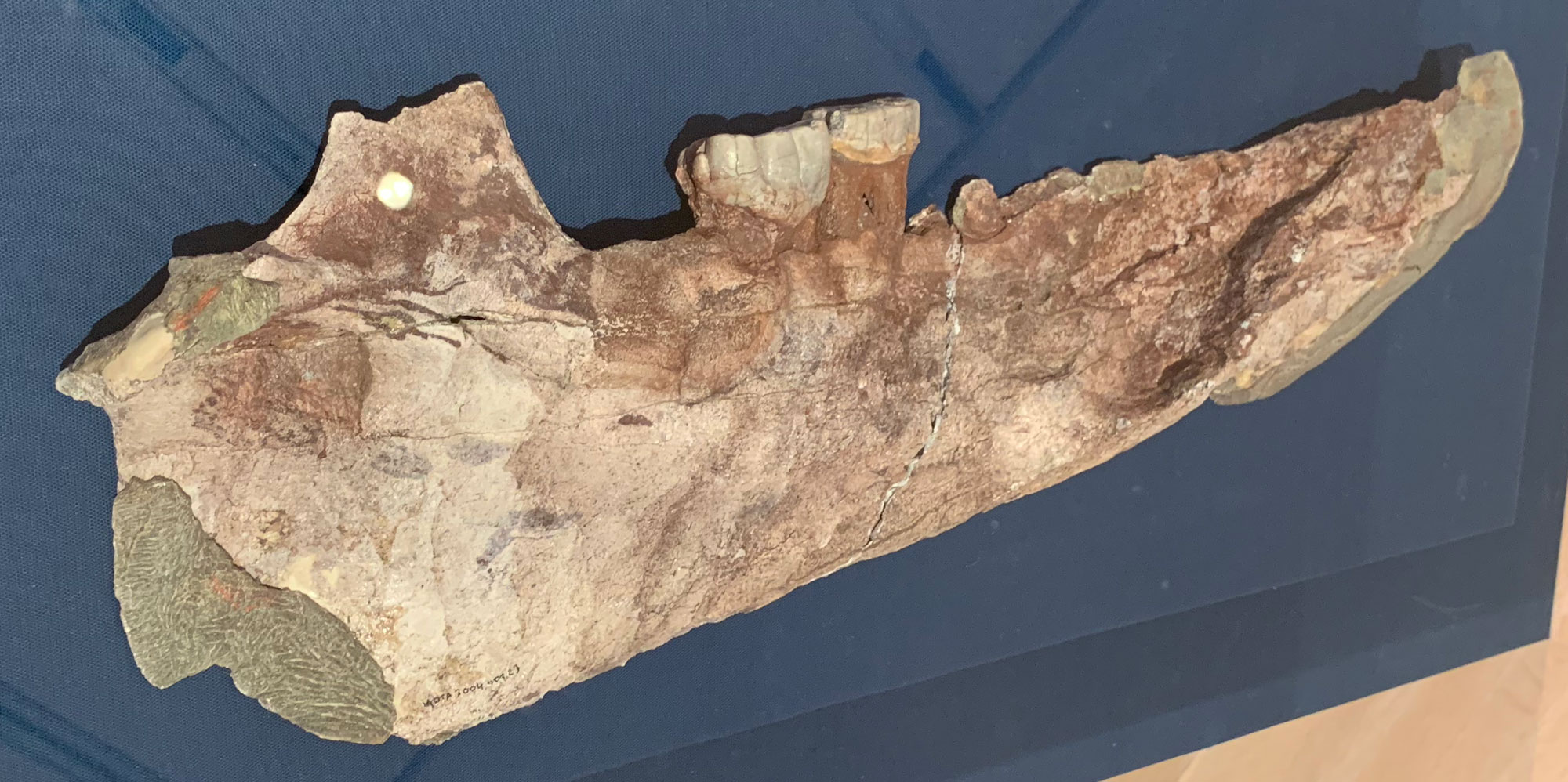
Fossil of a desmostylian (Ounalashkastylus tomidai) lower jaw, Unalaska, Alaska. Specimen on temporary display in the Alaska State Museum, Juneau, 2019. Photo by J. R. Hendricks (Earth@Home).
Quaternary fossils
Much of Alaska was covered in ice during the Pleistocene ice age, but some refuges did exist where terrestrial animals were able to persist. Beringia, the land bridge that allowed humans and other animals to pass into North America from Asia, was likely one of these refuges. Numerous mammal fossils can be found throughout the state. The area around Fairbanks has many Quaternary deposits that yield mammoth, mastodon, bison, and elk bones.

Skull of a steppe bison (Bison priscus), Pleistocene, Alaska. Photo by Michael Brett-Surman (Smithsonian National Museum of Natural History, public domain).

Skull of a moose (Alces alces), Pleistocene, Alaska. Photo by Michael Brett-Surman (Smithsonian National Museum of Natural History, public domain).
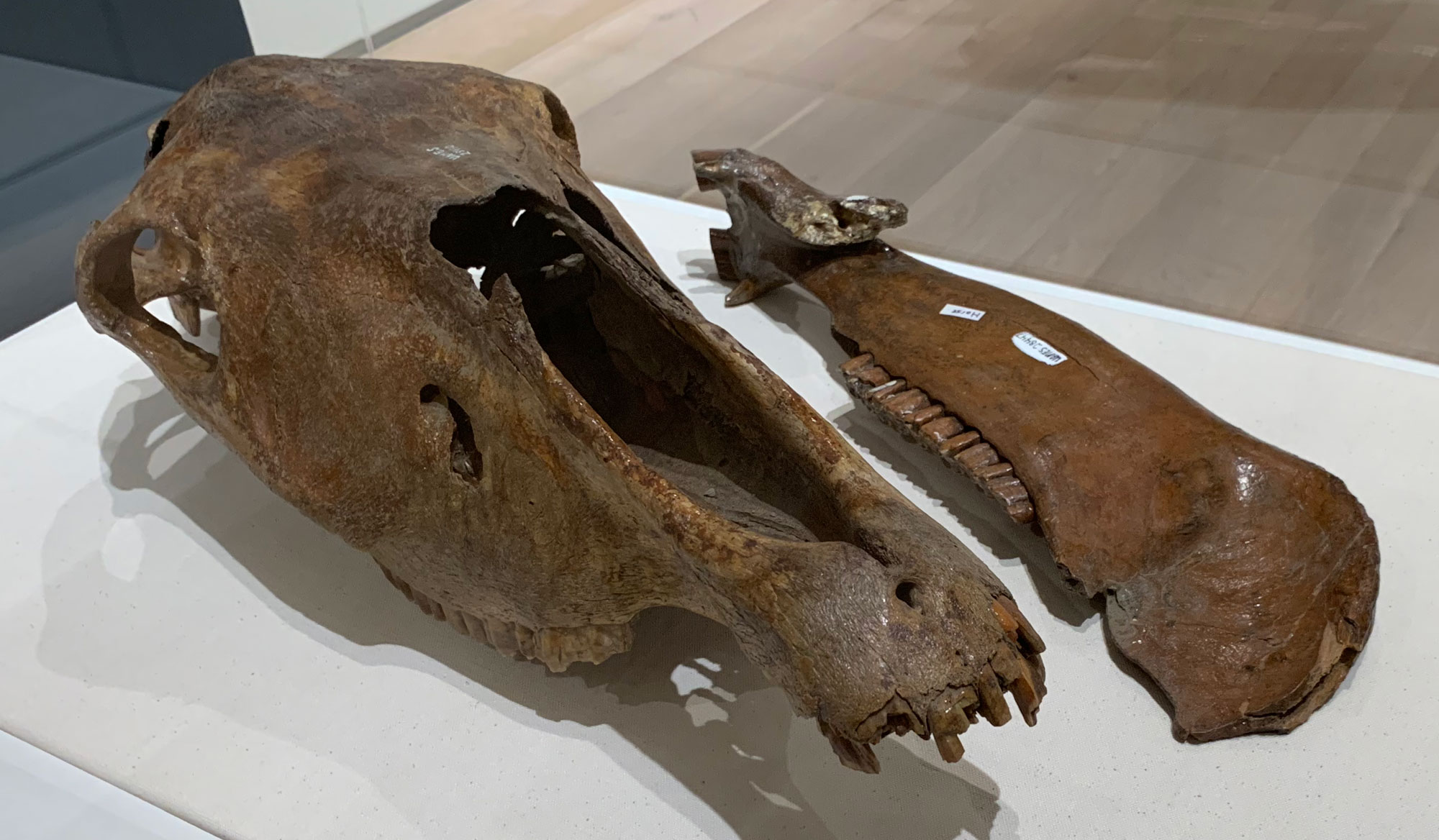
Skull of a horse, Pleistocene, North Slope, Alaska. Specimen on temporary display in the Alaska State Museum, Juneau, 2019. Photo by J. R. Hendricks (Earth@Home).
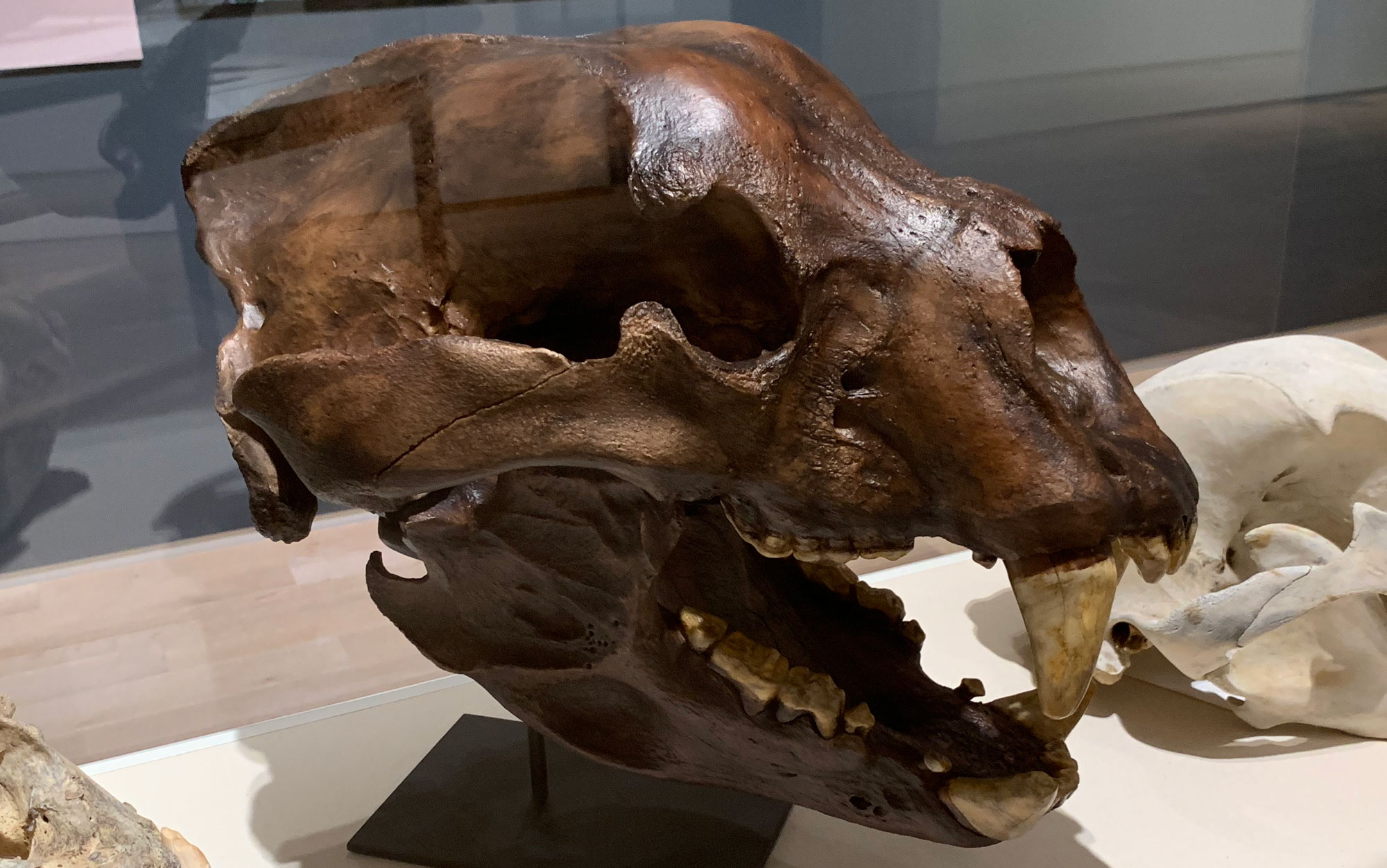
Skull of a short-faced bear (Artodus simus), Pleistocene, Alaska. Specimen on temporary display in the Alaska State Museum, Juneau, 2019. Photo by J. R. Hendricks (Earth@Home).
Pleistocene mummies
Rarely, frozen carcasses preserving hair and skin have been found in Alaskan permafrost, although such carcasses are more frequently found in Russia. The two most famous such mummies are "Effie," a baby woolly mammoth discovered in 1948 that is over 21,000 years old, and "Blue Babe," a steppe bison discovered in 1979 that is about 36,000 years old. Both were discovered during gold mining.
In 2012, another frozen steppe bison called "Bison Bob" was discovered in a riverbank. While Bison Bob's skeleton is nearly complete, Bison Bob is not completely mummified like Blue Babe. Nevertheless, some of Bison Bob's connective tissue and hair is preserved. Bison Bob is 43,000 years old.

Pleistocene mummies from Alaska on display in the Museum of the North, University of Alaska, Fairbanks. Left: Cast (reproduction) of "Effie" the baby mammoth (the original specimen is held by the American Museum of Natural History in New York City). Effie (E.F.) stands for Fairbanks Exploration (a mining company). Right: Photo of "Blue Babe," a steppe bison named after Babe the Blue Ox, who was the pet of the mythical lumberjack Paul Bunyan. Credits: Photo of "Effie" by Travis (flickr, Creative Commons Attribution-NonCommercial 2.0 Generic license, image cropped and resized). Photo of "Blue Babe" by Bernt Rostad (Wikimedia Commons, Creative Commons Attribution 2.0 Generic license, image cropped and resized).
The woolly mammoth
The woolly mammoth (Mammuthus primigenius) was a Pleistocene and early Holocene elephant that coexisted with humans. Woolly mammoths lived in both Eurasia and North America; in North America, their range extended from Alaska southeast to the northeastern United States. They were one of three species of mammoths that lived in North American during the Pleistocene. The other two were the larger Columbian mammoth (Mammuthus columbi), which ranged throughout most of the lower 48 U.S. states and into Mexico, and the small pygmy mammoth (Mammuthus exilis), which was found only on the Channel Islands in southern California.

Size comparison of the three types of mammoths found in the Pleistocene of North America. Diagram modified by a diagram by FunkMunk (Wikimedia Commons, public domain).
Woolly mammoths were similar to modern African elephants in size but had a heavy coat of fur, small ears, and a short tail to minimize heat loss. Mammoths primarily ate grasses and sedges and had flat teeth similar to those of modern elephants.
Most woolly mammoths, along with many other megafauna, went extinct during the Quaternary extinction event as a result of climate change and exploitation by human hunters; the relative contribution of each of these factors is still disputed. The youngest woolly mammoths from the United States come from St. Paul Island (a remote volcanic island located to the southwest of mainland Alaska), where they survived until about 5600 years ago. The last known woolly mammoths in the world survived on Wrangel Island (a Russian island to the north of eastern Russia and northwest of Alaska) until about 4000 years ago.

Model of a woolly mammoth on display at the Royal Victoria Museum, British Columbia, Canada. Photo by Thomas Quine (Wikimedia Commons, Creative Commons Attribution 2.0 Generic license, image resized).
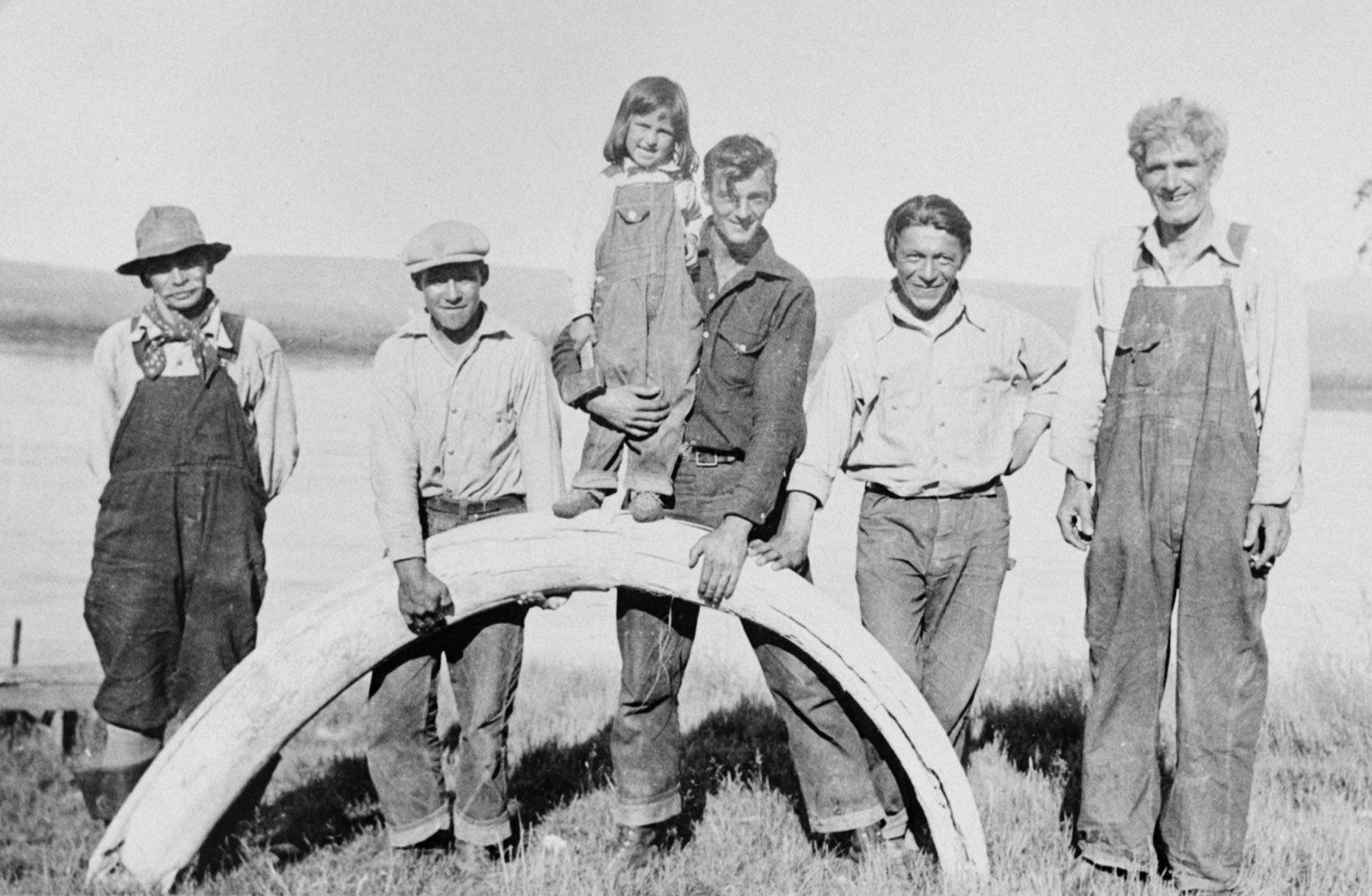
The Biederman family and their friends with a mammoth tusk, Yukon River, Alaska, 1930. Photo source: National Park Service/NPS (public domain).
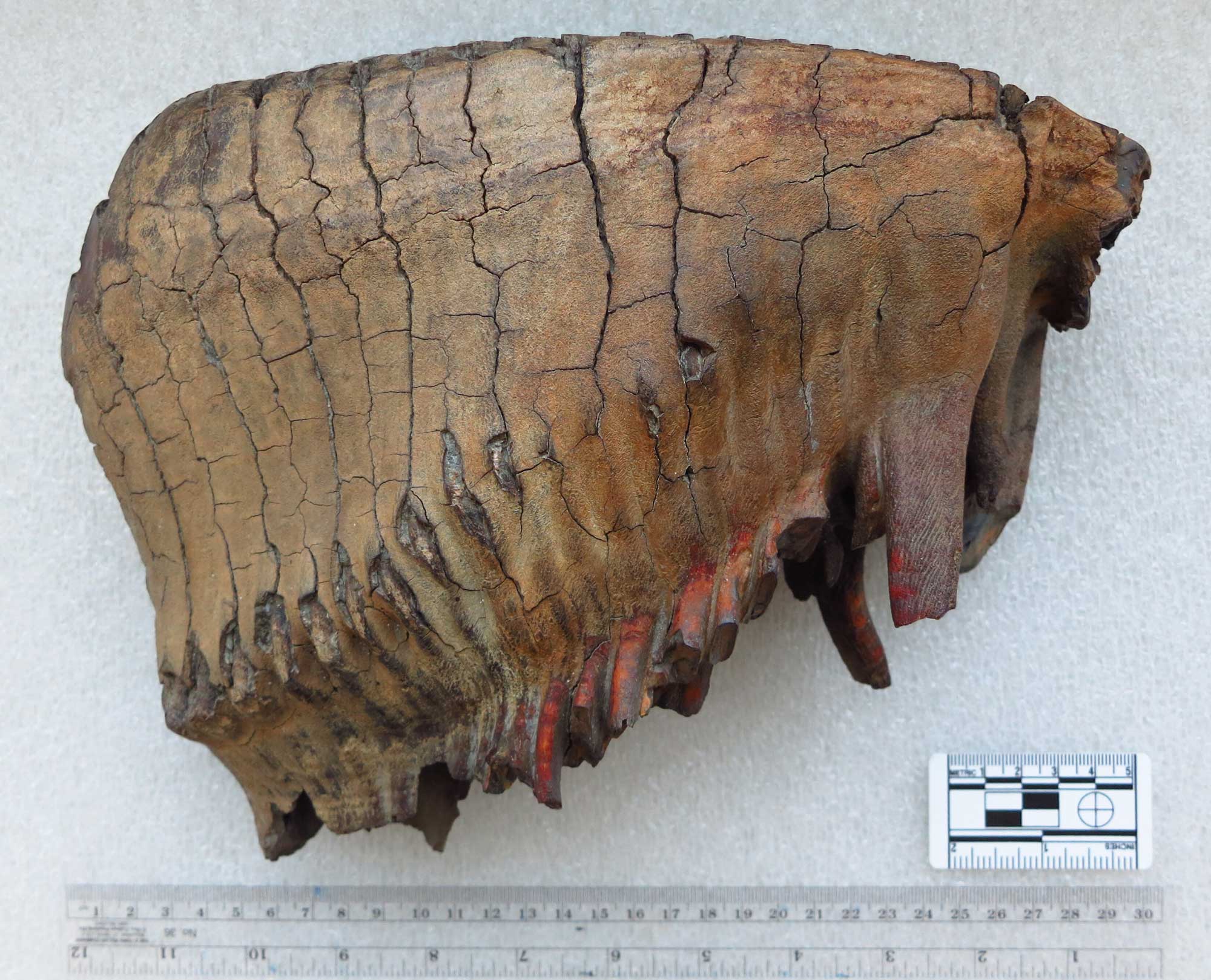
A large woolly mammoth molar, Pleistocene, Bering Land Bridge National Preserve, Alaska. This tooth was radiocarbon dated and is between 14,530 and 14,060 years old. Photo by Jeff Rasic (National Park Service/NPS, public domain).
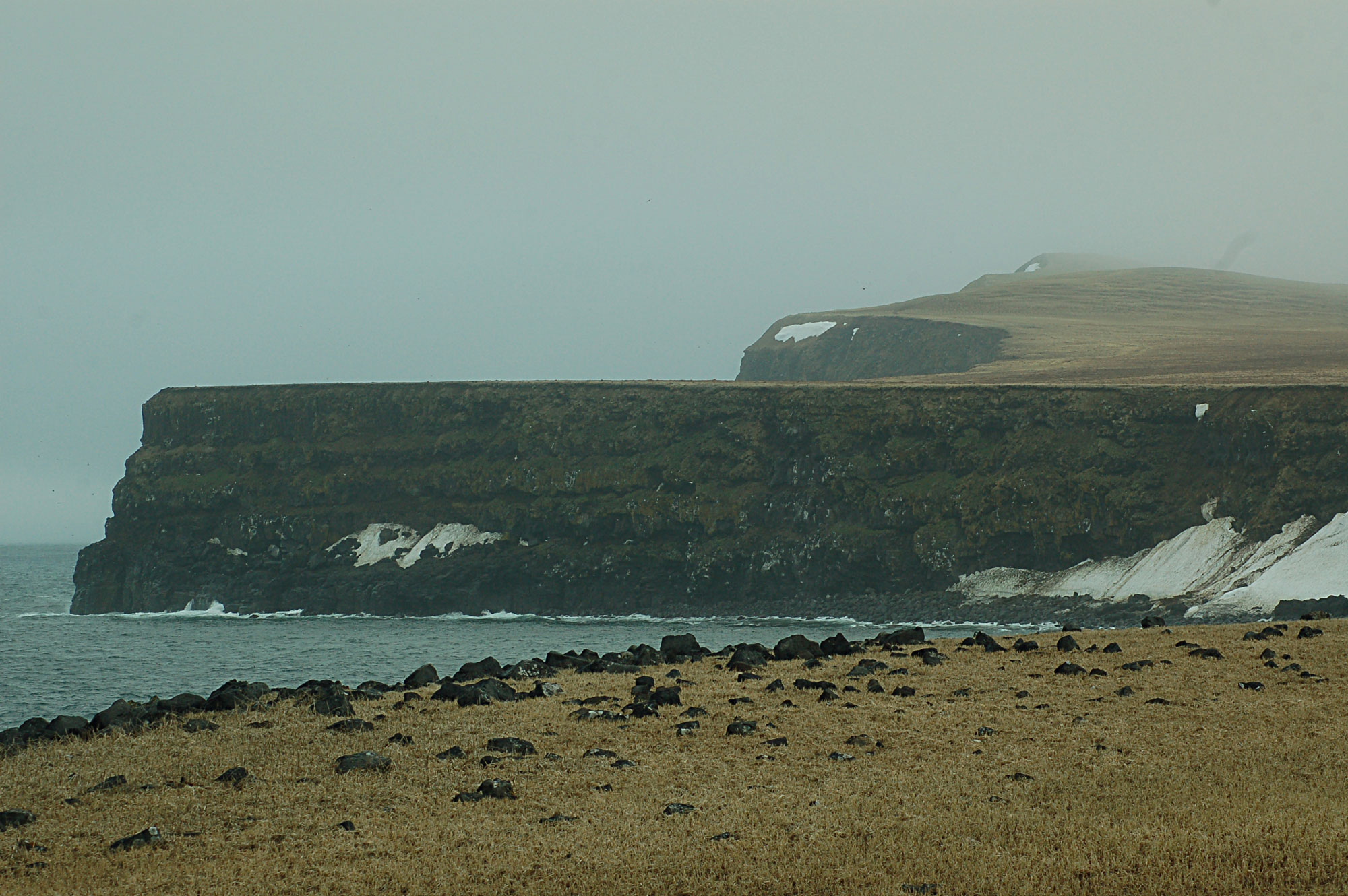
St. Paul Island, Pribilof Islands, southwestern Alaska, June 2012. Photo by Don Henise (flickr, Creative Commons Attribution 2.0 Generic license, image resized).
Resources
Resources from the Paleontological Research Institution
Digital Atlas of Ancient Life Virtual Collection: https://www.digitalatlasofancientlife.org/vc/ (Virtual fossil collection featuring 3D models of fossil specimens sorted by group)
Digital Encyclopedia of Ancient Life: https://www.digitalatlasofancientlife.org/learn/
Earth@Home: Quick guide to common fossils: https://earthathome.org/quick-faqs/quick-guide-common-fossils/



